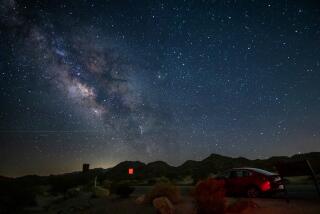Our Lights Make Stars an ‘Endangered Species’
- Share via
One in five humans in the world, and two-thirds of those in the United States can no longer see the bright band of stars called the Milky Way, according to a new study that assesses the extent of “light pollution” across the globe.
The research is the first to document the extent of the march of artificial light throughout the world. One in four people, the researchers said, lives under a night sky that is brighter than a full moon.
“The stars are an endangered species,” said Elizabeth Alvarez, associate director of the International Dark-Sky Assn. “That is a cultural loss.”
An estimated 2,000 stars are visible at night for viewers far from city lights. In cities, the number dips to a few dozen.
The study, called “The First World Atlas of the Artificial Night Sky Brightness,” will appear in a publication of the Royal Astronomical Society.
Researchers in Italy and at the U.S. government’s National Oceanographic and Atmospheric Administration matched world population density information with satellite images from 1996 and 1997 that showed the amount of light that scattered upward from the Earth’s surface.
Astronomers are moving farther from civilization to study the stars. Top viewing sites today include Antarctica, Mauna Kea on Hawaii’s Big Island and sites in the Chilean desert.
Alvarez said people can do their part to help combat light pollution by using “rational lighting levels”--not any more than needed--and pointing light to where it’s needed.






